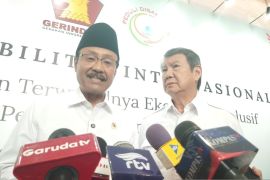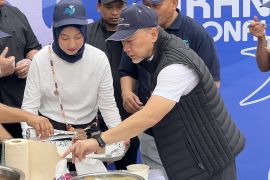However, around 25 percent of Indonesian children do not have access to proper food.
"What is the point of being a member of the G20 if 25 percent of our children do not have enough food?” President Prabowo Subianto stated at the Indonesia-Brazil Business Forum on the sidelines of the G20 Summit in Rio de Janeiro, Brazil, on November 17.
According to data from Statistics Indonesia (BPS), in 2023, there were 88.7 million children up to 19 years of age. This means more than 22 million children live with food insufficiency.
This situation also places Indonesia in the 77th position out of 127 countries in the world with a "moderate" level of food insecurity according to the latest Global Hunger Index report announced via the Global Hunger Index page.
The annual report published by the German non-governmental organization Welthungerhilfe reveals Indonesia's comparatively concerning position among G20 members.
Based on the report, 7.2 percent of Indonesia's population is malnourished, 26.8 percent of children are stunted, 10 percent of toddlers are malnourished, and 2.1 percent of toddlers have a mortality rate, with an accumulated score of 16.9.
In comparison, South Africa is in a better position than Indonesia, ranked 60th, with a score of 12.5. Meanwhile, India, with a serious hunger status, has a score of 27.3 at the 105th ranking.
Lessons from Brazil and India
At the G20 Summit in Brazil, Prabowo expressed keenness in adopting the free meal program approach in Brazil for children in Indonesia.
Brazil is known to face major challenges in overcoming poverty and hunger. Fome Zero or Zero Hunger is a priority program initiated by President Luiz Inácio Lula da Silva, elected in 2003, to ensure every Brazilian citizen can eat thrice daily.
Despite initial bureaucratic challenges and criticism, the president pushed ahead the implementation by appointing agricultural expert José Graziano da Silva to lead the program.
The government was able to produce healthy food and assisted local farmers in producing rice, eggs, meat, vegetables, and fruits and ensured access to credit and technical assistance for capital.
As a result, the hunger rate in Brazil has dropped significantly. In 2003, some 12 percent of Brazil's population, or 22 million people, suffered from hunger. That figure dropped to just 10 million by the end of Lula's term.
The program also increased children's participation in school as they received nutritious food, with the food portion depending on the economic conditions of the area.
Lula's success was recognized globally. In 2010, he was named Hero of the Eradication of Starvation by the United Nations World Food Programme (WFP). The Fome Zero program has become a model adopted in other countries, especially Africa, to address world hunger.
The latest report based on a survey by the Indonesian Coordinating Ministry for Human Development and Culture to Rio de Janeiro, Brazil, on July 23, showed the budget for this meal program involves central and state funds, with cost per student of around BRL1.5, or around Rp4,400 (USD0.27).
Several restaurants produce 1,800 to 3,000 free meals for the poor, the elderly, and the disabled. The general public was also charged a portion of food at an affordable price.
Apart from adopting the Brazilian scheme, Indonesia also studied the school lunch program in India, known as the Mid-Day Meal Scheme, launched to address malnutrition, support education, and eliminate hunger among children.
Started in 1925 in Chennai, this scheme evolved into a national program called PM Poshan Shakti Nirman (PM Poshan), which provides free lunches in government schools and government assistance.
Since 1995, this program has been officially expanded through the National Nutrition Support Program for Primary Education, aiming to improve participation, attendance, and nutritional status of children.
Over time, the government of India has updated the regulation, such as adjusting the nutritional content of food to include 700 calories and 20 grams of protein per serving.
This program is also mandated in the Food Security Law and helps ease the economic burden on families, which has brought a positive impact on the health, education, and development of the next generation.
Main Expert of the Presidential Communication Office, Hamdan Hamedan, stated that various studies in India show that Free Nutritious Meals for children can improve students' reading scores by up to 18 percent and mathematics by up to nine percent, including increasing child growth and reducing stunting in India.
Implementation in Indonesia
The Free Nutritious Meals (MBG) program in Indonesia is scheduled to start on January 2, 2025. In the initial stage, this program will run for three months, targeting three million beneficiaries and allocated a budget of Rp71 trillion (USD4.3 billion) from the State Budget.
After the trial, the quota will be increased until it reaches the target of 82.9 million people.
Each student will receive free nutritious food once a day, with food distribution carried out in three different schedules according to education level.
The budget is set at Rp10 thousand (USD0.61) per person per day, where Head of the National Nutrition Agency (BGN) Dadan Hindayana ensured that implementation in the field will be flexible, depending on the needs of each region.
He noted that the remaining budget from surplus regions will be allocated to the other areas needing additional funds, especially those with higher raw material prices.
The budget is not used to buy ready-made food packages but to purchase raw materials to be cooked on-site by involving the community and local catering businesses.
Each menu will have its own calculations, including the cost of labor to cook the food.
The agency also places a nutritionist in each MBG service unit tasked with ensuring the nutritional composition aligns with the national nutritional standards.
Furthermore, BGN has determined that village-owned enterprises (BUMDes) and cooperatives are suppliers of MBG raw materials and form 86 nutrition service units (SPG).
Those service units will be spread across villages and sub-districts, with a service scale of one to three thousand people, or one nutrition service unit serving three thousand people, which includes students from early childhood education (PAUD) to high school, pregnant and breastfeeding mothers, and toddlers.
The MBG program in Indonesia is designed to address the nutrition crisis and food security by emulating the success of similar programs in other countries.
With significant budget allocation and support from local communities, this program is expected to sustainably improve the quality of health and education and the future of Indonesia's young generation.
Related news: Free nutritious meal budget proven sufficient in Sukabumi: Official
Related news: Need 30,000 nutritionists for free meals program: official
Editor: Rahmad Nasution
Copyright © ANTARA 2024












